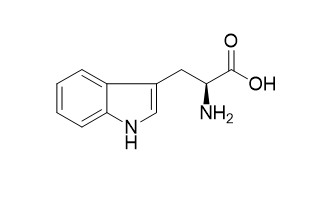L(-)-Tryptophan
Reference standards.
Inquire / Order:
manager@chemfaces.com
Technical Inquiries:
service@chemfaces.com
Tel:
+86-27-84237783
Fax:
+86-27-84254680
Address:
1 Building, No. 83, CheCheng Rd., Wuhan Economic and Technological Development Zone, Wuhan, Hubei 430056, PRC
Providing storage is as stated on the product vial and the vial is kept tightly sealed, the product can be stored for up to
24 months(2-8C).
Wherever possible, you should prepare and use solutions on the same day. However, if you need to make up stock solutions in advance, we recommend that you store the solution as aliquots in tightly sealed vials at -20C. Generally, these will be useable for up to two weeks. Before use, and prior to opening the vial we recommend that you allow your product to equilibrate to room temperature for at least 1 hour.
Need more advice on solubility, usage and handling? Please email to: service@chemfaces.com
The packaging of the product may have turned upside down during transportation, resulting in the natural compounds adhering to the neck or cap of the vial. take the vial out of its packaging and gently shake to let the compounds fall to the bottom of the vial. for liquid products, centrifuge at 200-500 RPM to gather the liquid at the bottom of the vial. try to avoid loss or contamination during handling.
Front Cell Infect Microbiol.2018, 8:292
Phytochem Anal.2016, 27(5):296-303
Bioengineering2023, 10(10), 1113.
Mol Divers.2022, s11030-022-10586-3.
Analytical Letters.2020, doi 10.1008
Environ Toxicol.2020, doi: 10.1002
Evid Based Complement Alternat Med.2017, 2017:7383104
PLoS One.2017, 12(8):e0181191
Korean J Pain.2021, 34(4):405-416.
Biomedicines.2024, 12(12):2928.
Related and Featured Products
Neuropharmacology, 1976, 15(6):339-344.
Dose-response relationships between systemically administered l-tryptophan or l-5-hydroxytryptophan and raphe unit activity in the rat.[Reference:
WebLink]
METHODS AND RESULTS:
In contrast to previous reports that l-5-hydroxytryptophan (l-5-HTP) is without effect on raphe unit activity, systemic administration of l-tryptophan(L(-)-Tryptophan) or l-5-HTP produced similar dose-dependent decreases in raphe unit activity, ranging from 0–15% at 10 mg/kg to 60–90% at 100 mg/kg doses. The dose-response curve forms a plateau for doses above 100 mg/kg of l-5-HTP or l-tryptophan. Neurochemical studies revealed that administration of varying doses of l-tryptophan or l-5-HTP (10–100 mg/kg, i.p.) under conditions simulating those of the unit recording procedure, produced dosedependent increases in forebrain serotonin of up to 42% and 353% for a 100 mg/kg dose of l-tryptophan or l-5-HTP, respectively.
CONCLUSIONS:
These data suggest that exogeneously administered l-5-HTP serves as an effective serotonin precursor in central serotonergic neurones. Furthermore, increases in forebrain serotonin levels within the range of normal diurnal variations dramatically depress raphe unit activity, indicating that diurnal changes in brain serotonin metabolism may significantly affect the activity of serotonin-containing neurones.



